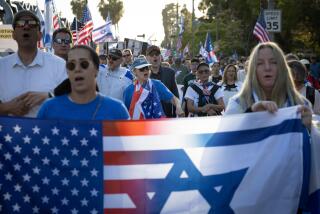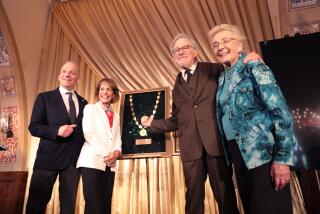Attitudes Toward Shia Muslims Take More Tolerant Direction
- Share via
After 37 years in America, Cerritos physician Ridha Hajjar can recite a history of tough times for Shia Muslims, who predominate in places such as Iraq -- where they have long been shut out of power -- and Iran.
He recalls the harassment of the Shia, Islam’s largest minority sect, by some majority Sunnis. He remembers the stereotypes slapped on them as violent fanatics after the 1979 seizure of American hostages by Iranian revolutionaries.
He ruefully relates how his wife called U.S. officials to protest the slaughter of Shias who rose up against Saddam Hussein after the 1991 Persian Gulf War: “So what? They’re just Shiites,” Hajjar says she was told.
“That’s why we feel bitter -- the whole world has been ignoring us,” Hajjar says.
No longer. Suddenly, with the U.S. war in Iraq and subsequent occupation, the Shia are in the spotlight, often sympathetically portrayed as the courageous victims of Hussein. Suddenly, their holy cities and religious rituals are being covered around the world. Suddenly, they are gaining access to U.S. policymakers.
At the opening conference of the country’s first nationwide Shia organization recently, for instance, U.S. Deputy Secretary of Defense Paul Wolfowitz gave the keynote address. He lamented their persecution, praised their creative geniuses, lauded their cooperation in Iraq and acknowledged that a “false image of Shia” had been projected to the world.
“There have been radical changes to the American perception regarding Shias,” said Imam Moustafa Al-Qawzini, a religious leader from a large family of Islamic scholars and activists in Southern California and Detroit.
But the spotlight has also magnified the challenges facing the nation’s Shias, a polyglot community that may make up more than 20% of the American Muslim population.
The nation’s oldest Shia community is in the Detroit area, where Lebanese immigrants began settling a century ago.
But California is home to the largest and most diverse Shia population, with more than 30 Shia mosques, still largely divided by culture and ethnicity.
In West L.A., for instance, the Iranian Muslim Assn. of North America offers Persian lessons and Iranian New Year celebrations, in addition to Islamic religious services.
In Pico Rivera, Swahili mingles with English in the Husseini Imam Bara Mosque, which is dominated by East Africans of Indian origin. In Cudahy, Southern California’s oldest Shia mosque is populated primarily by Pakistanis, while Bell’s mosque is mostly Lebanese.
Ethnic Differences
Religious attitudes differ as well. At the Iranian center, for instance, no curtain separates men from women and the hijab head covering is not required.
At the Pico Rivera center, by contrast, covered women pray in a separate room linked by video to the main prayer hall. The women say they prefer their own space where they can relax, remove their scarves and breast-feed their babies if they want to.
Those cultural differences, some community leaders say, have impeded efforts to develop an overall Shia identity that would preserve their distinctive religious heritage. The newly created Universal Muslim Assn. of America, billed as the Shia population’s first independent national organization, is one effort to foster greater cohesiveness.
Another need, many Shias say, is more dynamic religious leadership familiar with American sensibilities and able to hold the interest of youth.
Shias need to free themselves from “blind obedience” to their ayatollahs, said Abdulaziz Sachedina. A Shia scholar from the University of Virginia, Sachedina has called for equality between men and women and among Islam, Christianity and Judaism.
“Our religious leadership is in crisis because it’s lost relevance with the people,” he said.
In 1998, Ayatollah Ali Sistani of Iraq, one of the world’s most prominent Shia leaders, blacklisted Sachedina from speaking at Shia mosques. Sachedina is nonetheless pushing forward his campaign to empower the Shia to follow their own consciences.
The family of the imam Al-Qawzini, whose youthful energy and open manner make him particularly popular with young Muslims, has started a summer seminary with the eventual aim of developing home-grown Shia leaders articulate in English and familiar with contemporary American life.
Al-Qawzini, 41, is one of the few Shia leaders openly addressing sensitive issues of growing concern to Muslims, such as dating, divorce and sexual relations.
He also says that Shia leaders must move beyond lamenting their past persecutions and recast their message in a more positive direction -- using the stories of their martyred imams, for instance, to energize activity for social justice and religious tolerance.
A narrative of persecution is a central feature of the Shia religious heritage. A major religious commemoration known as Ashura, for instance, memorializes the martyrdom of their imam Hussein, the Prophet Muhammad’s grandson.
The commemoration is accompanied by tearful recitations of the tragedy and sorrowful chest-beating by the faithful -- practices that were broadcast worldwide in March, when millions of Iraqis were openly allowed to make the Ashura pilgrimage to sacred Karbala for the first time in decades.
Such practices are foreign to Sunnis. Relations between the two groups remain a sensitive challenge.
Differences between the two groups date nearly to the faith’s founding 1,400 years ago. Although both groups follow the fundamentals of Islam, such as the oneness of God and the role of Muhammad as divine messenger, they disagree on questions of leadership.
Shia Muslims believe that the most qualified leaders of the new faith community were descendants of the prophet appointed by him, ordained by God and supported by the people; most Shias support a line of 12 imams that began with the prophet’s cousin and son-in-law, Ali. Sunni Muslims, however, say they support leaders selected from the community at large.
Seeking Unity
Sectarian hatred rages between the two groups in some parts of the world. In Pakistan, for instance, Shias are blaming Sunni extremists for a bomb attack on one of their mosques in Karachi last week that killed at least 44 worshipers.
In the United States, the vast majority of Muslims say they believe unity among all sects is desirable. But one study of Southern California Muslims, conducted in 1994, found what researcher Kambiz Ghanea Bassiri called a “strange form of tolerance” in which Sunni-dominated mosques accepted the physical presence of Shias, but not their rituals.
Shia leaders cite cases in which they were expelled from mosques when they attempted to commemorate Ashura, were denied permission to bury their dead in Muslim cemeteries or found their scholars boycotted by the Sunni majority.
Such problems mounted after the Iranian revolution, when Iran’s Ayatollah Ruhollah Khomeini called for the ouster of the Saudi monarchy. Muslims from both sides say that Saudi Arabia, an orthodox Sunni state, flooded mosques here and abroad with anti-Shia literature.
Today, however, such tensions have cooled.
“We look at the Shia-Sunni difference as historical, obsolete and irrelevant to the challenges Islam is facing in the modern times,” said Maher Hathout, spokesman for the Islamic Center of Southern California, which refused to accept the anti-Shia material.
Aiming for Diversity
In Sacramento, a new office of the Council on American-Islamic Relations features a diverse executive committee of both Sunnis and Shias. And on college campuses, more students say they are developing a “Pan-Muslim” identity that embraces the richness of both major sects without explicitly identifying as either.
Jameelah Shukri was raised as a Sunni and met Shia Muslims for the first time at Orange Coast College in Costa Mesa, where she was a student. Curious to explore Shia traditions, she ended up captivated.
Shukri, who expects to study Spanish and political science at UCLA this fall, said the Shia tradition offers rich stories about Muhammad and his family, and the prayer rituals give her a deep sense of peace. “The rituals make your heart feel at ease, especially with life being so chaotic,” she said.
Shukri, 19, said Shiaism has even become something of a trend among students, with dozens embracing the tradition. Two years ago, the 14-campus Muslim Student Assn. West elected a Shia president.
Those gains, however, have sparked something of a backlash against Shia leadership, Shukri and others say. Earlier this year, some Sunni students tried to block their Shia counterparts from sponsoring an Ashura commemoration at UC Irvine.
Both groups went to Sadullah Khan, a Muslim leader who works with students on three campuses.
“At this moment in our time, when there is so much criticism of Islam, why argue about insignificant, futile issues?” Khan said he told them.
Khan is the religious director of a new Islamic center in Irvine that he says welcomes all Muslims. Asked if Shia speakers will be invited and Shia rituals allowed, Khan replied: “Of course. Why not?”
“Muslim is Muslim,” Khan said. “End of story.”
More to Read
Sign up for Essential California
The most important California stories and recommendations in your inbox every morning.
You may occasionally receive promotional content from the Los Angeles Times.














